Feature: Hope and sorrow in Jordan's no man's land
Feature: Hope and sorrow in Jordan's no man's land

RUWEISHED, Jordan (UNHCR) - "I had hoped and hoped, but the moment I heard I was given the opportunity to go to Sweden, I could not believe it, really. It suddenly made everything worthwhile."
Yazin's eyes shine with hope. At 29, he has spent almost his entire life in refugee camps. Now he is one of a group of 384 Iranian Kurds who have been accepted for resettlement by Sweden, after spending a year and a half in the no man's land between Iraq and Jordan.
Yazin was only a child when his family fled the Islamic Revolution in Iran and took refuge with relatives on the other side of the border, in the northern Iraqi town of Sulaymaniyah. They stayed there for two years before ending up in the refugee camp of Al Tash, close to Baghdad.
Al Tash was to be his home for the next two decades. At the age of eight, the little boy discovered his own way of escape from his grim surroundings: he started drawing and painting. In the absence of any creative classes or workshops in Al Tash, he had to teach himself to paint. He became so good at it that after a while, many of the camp's refugees started coming to him to ask for their portraits.
Little by little, painting became a way of life, a tenuous hold on hope. "This was what helped me through the difficult life in all those years," he says.
In 2003, momentous events shook Iraq and like many of the 12,000 Iranian Kurds then living in Al Tash, Yazin and his family decided to look for a better life elsewhere after the downfall of Saddam Hussein. Where to go was a difficult decision for him.
"I did not want to return anymore to Iran, because of my different political beliefs," Yazin says. "At the same time, after all those years, I had no more hope in Iraq. As an artist, I felt my soul was dying, surrounded by desperate people inside the camps."
In the first half of 2003, Yazin, his wife and their two children left for Jordan. They made it no further than the no man's land between Iraq and Jordan. Amman, having shown much hospitality to refugees over the years, refused to let this new group in. More than 1,000 people found themselves stranded in the no man's land, an arid desert with freezing temperatures in winter, extreme heat during the summer and frequent sandstorms in all seasons - a place only scorpions and snakes find hospitable.
This desperate spot was to remain Yazin's home for the next 18 months. For him and his family, life had, yet again, taken a turn for the worse and yet again, it was art that kept Yazin from despair. With the help of UNHCR and the international non-governmental organisation, CARE, Yazin set up a studio for artists and started teaching other refugees painting and drawing.
"It provided an opportunity for all to express their misery and their hopes.
It was a very, very difficult time," Yazin recalls. "I am grateful that I was given a talent, because amidst all the misery, it allowed me to focus on that."
Over the past year, UNHCR has advocated very strongly for a solution for the "lost" people at the Jordanian border but until recently, very few countries had shown willingness to offer solutions to the 1,048 people - mainly Iranian Kurds but also some Palestinians, Iraqis, Sudanese, Egyptians and others - still stranded in the no man's land.
UNHCR submitted some 880 cases for resettlement to countries such as the United States, Australia and the Scandinavian countries, and in June 2004, good news came for some: Sweden had accepted 384 of them for resettlement. Yazin was among them. It was like a dream come true for the whole family. His brother-in-law had immigrated to Sweden in 1997, and they had dreamt of Sweden as "a free country, without religious problems, without war, where people could actually lead a simple and quiet life," says Yazin.
The 384 "lucky ones" were recently transferred from the no man's land to Ruweished camp, inside Jordan, where the Swedish government has been providing them with orientation briefings. The group is now waiting for all the documentation to be ready before they can finally set off for their new life in Sweden.
Yazin is very excited about going to Sweden. He wants to continue his studies, go to an art institute and make a living from his art.
"Sweden saved me from the no man's land that was like a prison to me. I felt like a disabled person there. I felt so impotent, not being able to work or provide food for my family. I like to work and support my family and one day, maybe one day, my paintings will become famous, just like the Mona Lisa, who knows!"

For those who are left behind, there is anger and sadness. Anger that solutions are found for others, but not for them. Sadness, because life seems without hope. Finding solutions for the Palestinian refugees is proving especially difficult and in Ruweished camp, one Palestinian man reached such depths of depression that he sewed his lips together, having given up on all his attempts to cry out for help.
UNHCR's Representative in Jordan, Sten Bronee, says, "We are very happy that this group of Iranian Kurds will be able to start a new life. But we will not rest until we have found solutions for all those remaining in this desperate place. Unfortunately, UNHCR can only advocate and promote, the solutions have to come from elsewhere - and they must come soon."
By Astrid van Genderen Stort in Ruweished, Jordan








